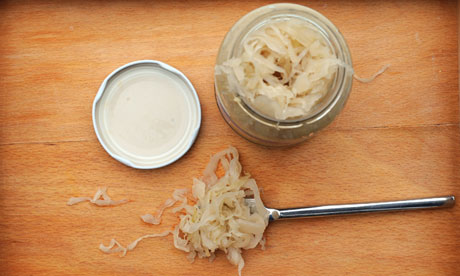
It's hard enough to persuade people to eat fresh cabbage, let alone sauerkraut, the yellow-beige fermented sort that sells for a suspiciously low price in Stalinist-looking jars. Most British people don't "get" preserved cabbage, but Germans and Poles famously consume it with gusto, as do the French. The Chinese and Koreans are big on fermented brassicas too.
Do not confuse sauerkraut with vinegary, pickled cabbage. Sauerkraut isn't noticeably salty, vinegary (though slightly sour, of course) or even crunchy. Rather, it has a comfortingly soft texture, and a mild acidity that makes it an ideal foil for fattier meats. Rinsing makes it mellower still.
Sauerkraut is made by lactic fermentation, an age-old technique now in vogue for its health benefits. The necessary bacteria and yeasts are naturally present on cabbage leaves. Apart from salt, which starts the process, no other ingredients are required. So avoid buying brands with added chemical preservatives.
Why is it good for me?
Cabbage contains natural isothiocyanate compounds (such as sulforaphane), which have cancer-fighting properties. And as long as you choose the unpasteurised sort, sauerkraut is teeming with beneficial lactobacillus bacteria – more than is in live yoghurt – which increase the healthy flora in the intestinal tract. This helps the immune system fight infection, and aids digestion, hence sauerkraut's venerable reputation as a remedy for upset stomach and constipation.
Where to buy and what to pay
Polish shops, some supermarkets and German discount chains sell 930g jars for about £1. Unpasteurised sauerkraut costs more, but can be made for pennies with just cabbage and salt.
• Joanna Blythman is the author of What To Eat (published by Fourth Estate). Order a copy for £11 with free UK p&p from guardianbookshop.co.uk or call 0330 333 6846
• This article was amended on 21 January 2013 because the original standfirst called sauerkraut "pickled beige cabbage". Sauerkraut is fermented.

